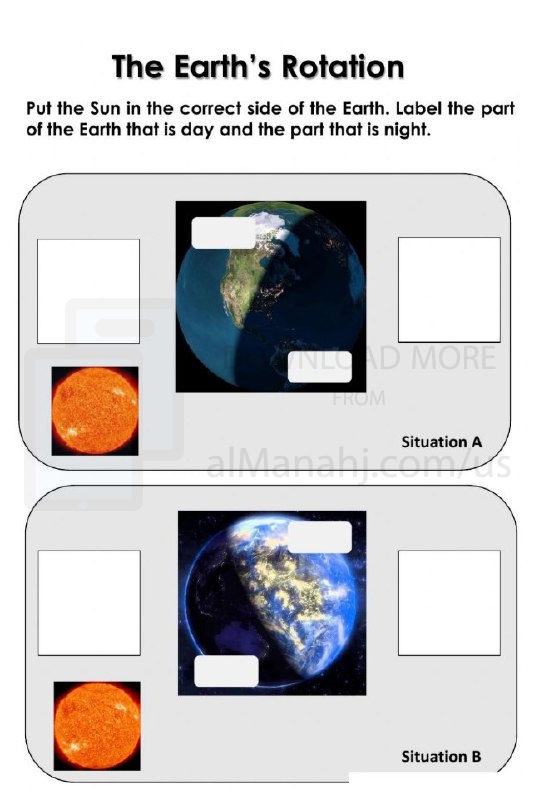| You are here: Almanahj Website ⇒ American curriculum ⇒ 8th Grade ⇒ Geology ⇒ Term 1 | ||
|---|---|---|
Worksheet about The Earths Rotation | ||
|---|---|---|
| Subject: Geology | ||
| 8th Grade | ||
| Term 1 | ||
| Year: 2023/2024 | ||
| Size: 304KB | ||
| Number of clicks: 133 | ||
| Publish date:November 24, 2023 | ||
| Added by: Eman | ||
| Last download date: 2024-09-08 06:41:46 | By: theodor Hanisah Aziz | |
| File info: The Earth's rotation refers to the spinning motion of the planet around its axis. Here are some key points about the Earth's rotation: 1. Axis of Rotation: The Earth rotates around an imaginary line called its axis. The axis is an imaginary line that runs through the planet from the North Pole to the South Pole. It is tilted with respect to the plane of the Earth's orbit around the Sun, which gives rise to the changing seasons. 2. Rotation Period: The Earth takes approximately 24 hours, or one day, to complete a full rotation. This period is known as a solar day. The rotation is counterclockwise when viewed from above the North Pole, which means that the Sun appears to rise in the east and set in the west. 3. Effects of Rotation: The rotation of the Earth has several important effects. It causes the alternation between day and night as different parts of the planet are exposed to sunlight or in darkness. The rotation also affects the movement of atmospheric air masses, giving rise to global wind patterns. 4. Coriolis Effect: The Earth's rotation gives rise to the Coriolis effect, which is the deflection of moving objects (including air and water currents) caused by the rotation. In the Northern Hemisphere, moving objects are deflected to the right, while in the Southern Hemisphere, they are deflected to the left. The Coriolis effect influences the formation of weather systems, ocean currents, and the rotation of large-scale atmospheric circulation patterns. 5. Day Length Variation: While the Earth's rotation period is roughly 24 hours on average, it is not constant throughout the year. The axial tilt of the Earth causes variations in the length of daylight hours throughout the year, leading to the changing seasons. During the summer solstice, one hemisphere (either the Northern or Southern Hemisphere) experiences its longest day, while the other hemisphere has its shortest day. 6. Earth's Shape: The Earth's rotation affects its shape. Due to the centrifugal force generated by the rotation, the Earth is not a perfect sphere but rather an oblate spheroid. The equatorial diameter is slightly larger than the polar diameter, causing the planet to bulge at the equator and flatten at the poles. 7. Time Zones: The Earth's rotation is the basis for the division of the planet into time zones. As the Earth rotates, different regions experience different times of the day. Time zones are established to standardize time across different regions and facilitate global coordination and communication. Understanding the Earth's rotation is crucial for various scientific disciplines, including astronomy, meteorology, and navigation. It plays a fundamental role in shaping Earth's climate, weather patterns, and the daily rhythms of life on our planet. | ||
| Downloading link Worksheet about The Earths Rotation |
|---|
|
1700835226.pdf
The file is being prepared for download
|
| File images |
|---|
 |